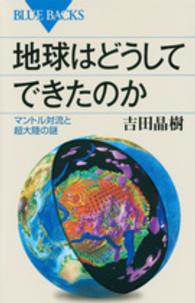- ホーム
- > 洋書
- > 英文書
- > Science / Mathematics
Full Description
Oil and gas still power the bulk of our world, from automobiles and the power plants that supply electricity to our homes and businesses, to jet fuel, plastics, and many other products that enrich our lives. With the relatively recent development of hydraulic fracturing ("fracking"), multilateral, directional, and underbalanced drilling, and enhanced oil recovery, oil and gas production is more important and efficient than ever before. Along with these advancements, as with any new engineering process or technology, come challenges, many of them environmental.
More than just a text that outlines the environmental challenges of oil and gas production that have always been there, such as gas migration and corrosion, this groundbreaking new volume takes on the most up-to-date processes and technologies involved in this field. Filled with dozens of case studies and examples, the authors, two of the most well-known and respected petroleum engineers in the world, have outlined all of the major environmental aspects of oil and gas production and how to navigate them, achieving a more efficient, effective, and profitable operation.
This groundbreaking volume is a must-have for any petroleum engineer working in the field, and for students and faculty in petroleum engineering departments worldwide.
Contents
Acknowledgments xvii
1 Environmental Concerns 1
1.1 Introduction 1
1.2 Evaluation Approach 3
1.3 Gas Migration 3
1.4 Underground Gas Storage Facilities 7
1.5 Subsidence 9
1.6 Emissions of Carbon Dioxide and Methane 10
1.7 Hydraulic Fracturing 11
1.8 Oil Shale 13
1.9 Corrosion 14
1.10 Scaling 14
1.11 Conclusion 15
References and Bibliography 15
2 Migration of Hydrocarbon Gases 17
2.1 Introduction 17
2.2 Geochemical Exploration for Petroleum 20
2.3 Primary and Secondary Migration of Hydrocarbons 20
2.4 Origin of Migrating Hydrocarbon Gases 23
2.5 Driving Force of Gas Movement 34
2.6 Types of Gas Migration 49
2.7 Paths of Gas Migration Associated with Oilwells 61
2.8 Wells Leaking Due to Cementing Failure 69
2.9 Environmental Hazards of Gas Migration 74
2.10 Migration of Gas from Petroleum Wellbores 78
2.11 Case Histories of Gas Migration Problems 79
2.12 Conclusions 97
References and Bibliography 98
3 Subsidence as a Result of Gas/Oil/Water Production 105
3.1 Introduction 105
3.2 Theoretical Compaction Models 108
3.3 Theoretical Modeling of Compaction 111
3.4 Subsidence Over Oilfields 119
3.5 Case Studies of Subsidence over Hydrocarbon Reservoirs 130
3.6 Concluding Remarks 178
References and Bibliography 179
4 Effect of Emission of CO2 and CH4 into the Atmosphere 187
4.1 Introduction 187
4.2 Historic Geologic Evidence 189
4.3 Adiabatic Theory 197
References 207
5 Fracking 211
5.1 Introduction 211
5.2 Studies Supporting Hydraulic Fracturing 211
5.3 Studies Opposing Hydraulic Fracturing 212
5.4 The Fracking Debate 213
5.5 Production 214
5.6 Fractures: Their Orientation and Length 217
5.7 Casing and Cementing 218
5.8 Blowouts 219
5.9 Horizontal Drilling 220
5.10 Fracturing and the Groundwater Contamination 220
5.11 Pre-Drill Assessment 220
5.12 Basis of Design 222
5.13 Well Construction 222
5.14 Summary 227
5.15 Failure and Contamination Reduction 227
5.16 Frack Fluids 230
5.17 Common Fracturing Additives 231
5.18 Typical Percentages of Commonly Used Additives 232
5.19 Chemicals Used in Fracking 233
5.20 Proppants 235
5.21 Slickwater 238
5.22 Direction of Flow of Frack Fluids 239
5.23 Subsurface Contamination of Groundwater 239
5.24 Spills 242
5.25 Other Surface Impacts 243
5.26 Land Use Permits 243
5.27 Water Usage and Management 244
5.28 Earthquakes 246
5.29 Induced Seismic Event 246xiv Contents
5.30 Wastewater Disposal Wells 247
5.31 Site Remediation 247
5.32 Examples of Legislation and Regulations 248
5.33 Frack Fluid Makeup Reporting 249
5.34 Atmospheric Emissions 250
5.35 Air Emissions Controls 252
5.36 Silica Dust 254
5.37 The Clean Air Act 255
5.38 Regulated Pollutants 255
5.39 Attainment versus Non-attainment 257
5.40 Types of Federal Regulations 257
5.41 MACT/NESHAP 257
5.42 NSPS Regulations: 40 CFR Part 60 258
5.43 Construction and Operating New Source Review Permits 260
5.44 Title V Permits 260
5.45 Chemicals and Products on Locations 260
5.46 Material Safety Data Sheets (MSDS) 263
5.47 Contents of an MSDS 263
5.48 Conclusion 264
State Agency Web Addresses 264
References 265
Bibliography 266
6 Corrosion 269
6.1 Introduction 269
6.2 Definitions 270
6.3 Electrochemical Corrosion 273
6.4 Galvanic Series 280
6.5 Types of Corrosion 289
6.6 Classes of Corrosion 293
6.7 Stress-Induced Corrosion 295
6.8 Microbial Corrosion 298
6.9 Corrosion Related to Oilfield Production 307
6.10 Economics and Preventitive Methods 321
6.11 Corrosion Rate Measurement Units 322
References and Bibliography 322
7 Scaling 329
7.1 Introduction 329
7.2 Sources of Scale 330
7.3 Formation of Scale 332
7.4 Hardness and Alkalinity 334
7.5 Common Oilfield Scale Scenarios 334
7.6 Prediction of Scale Formation 339
7.7 Solubility of Calcite, Dolomite, Magnesite and Their Mixtures 345
7.8 Scale Removal 345
7.9 Scale Inhibition 347
7.10 Conclusions 348
References and Bibliography 348
Appendix A 351
About the Authors 377
Author Index 379
Subject Index 387







